Home-made sand filter for the pool: we design and connect independently
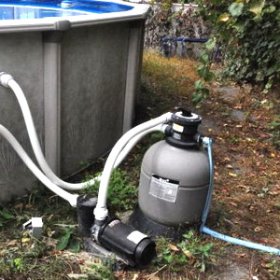
Nearly everyone now has a pool in the countryside. Someone chooses an inflatable as the most economical and small-sized option. Its daily cleaning and filling is not a hassle. The design on metal supports will stand all summer. You can swim with the whole family. The truth will have to take care of the periodic purification of water from suspended particles. But if it is planned to build a large pool on the site, then during its design it is necessary to provide for a stationary filtration system. To maintain cleanliness in large tanks, it is better to stop at the more expensive diatoms or coal ones. Well, and with small volumes of water the budget sand filter for the pool perfectly copes.
The surface of the water in the outdoor pool is quickly covered with a layer of dirt. And although its thickness barely reaches 0.1 mm, no one will want to swim anymore, and an unpleasant smell will spoil the rest in the country.
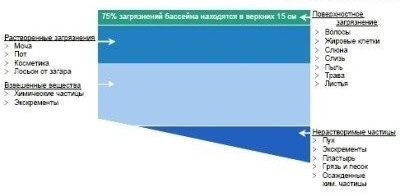
Surface cleaning of the pool is not enough to maintain cleanliness. Sweat, chemical particles, dust, grass and various microorganisms not only threaten the flowering of water, but can also cause various diseases. The only way to clean the entire thickness of the water is to install a filter that is suitable for the power in this pool
Some contaminants quickly dissolve in the water column, and a certain percentage settles in the form of black deposits at the bottom. It’s impossible to remove all this with a net. To clean the surface of a dirty film, you can arrange overflow. This will partially remove it due to the natural movement of water, which must necessarily fall into the filtration system, otherwise flowering is guaranteed.
To clean the pool bottom from dark deposits and settled dirt, you need to use the so-called "water vacuum cleaner". But in order to avoid such troubles, it is enough to simply keep the entire water column clean with the help of special filters for pools.
Content
The main types of "pool" filters
Three types of filter units can be used to purify water in the pool:
- sandy;
- diatoms;
- cartridge.
Unit # 1 - sand filter
Sand filter systems are the most affordable and easiest way to keep a small private pool clean and tidy. The sand filter consists of a tank, a pressure gauge and a six-position valve. The filter medium is quartz sand of several fractions, which is capable of retaining particles with a diameter of about 20 microns.This is enough to keep the water relatively clean.
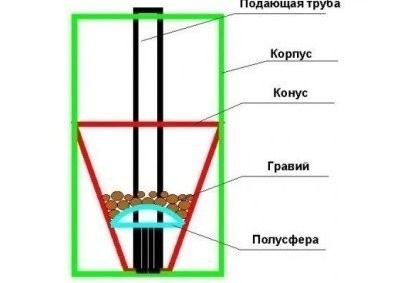
The hemisphere in the diagram is a rough water filter. It is needed so that sand does not get into the pool from the water barrel. Its role can be performed by a container wrapped in nylon fabric
Through a skimmer or overflow tank, water through a pipe enters the filter unit. Under pressure, it passes through quartz sand, which traps various particles of dirt, and then through nozzles it falls back into the pool. The filtering mass can consist only of sand, of several sand-gravel or sand-gravel-carbon-anthracite layers. The last two fillers purify water much better. If glass sand is used instead of quartz, then a complete replacement of the filter material will be needed not after three years, but after five to six years.
Naturally, after some time, the filter becomes clogged, and the pressure gauge indicates an excess of working pressure. Filter cleaning is performed by backwashing approximately every seven to ten days, after which the installation can continue normal operation. If the site has its own source of water, then such frequent cleaning does not affect the budget. But if we are talking about a pool in the city, then the meter will wind several additional cubic meters per month.
The device of the sand filter for the pool is so simple that many craftsmen prefer to assemble them themselves, adjusting in accordance with their own needs.
Unit # 2 - plant with diatom filler
A filter based on diatomaceous earth is considered the most reliable and most expensive. It allows you to remove suspended particles with a diameter of up to 1 micron from water. This soil contains silicon dioxide, which gives some healing properties to water, which is usually called silicon.
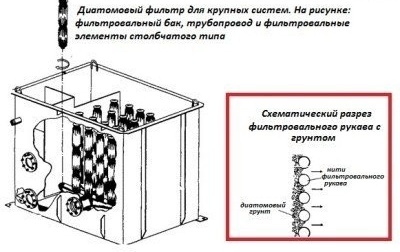
The diatom filter is the most expensive of all three, but it is it that allows not only to purify the water, but also gives it some healing properties. So you can be tempered and healed
The diatomaceous earth itself is a sedimentary rock formed as a result of the petrification of shells of diatoms. It has a yellow brown or gray color. If necessary, the filter layer is cleaned with backwash. If a complete replacement of the diatom mixture is required, remember that it belongs to the category of “Hazardous waste” and requires special disposal.
Unit # 3 - cartridge filtering system
The third kind of pool filtration systems are cartridge filters. The cleaning element - cartridge - consists of several layers of special paper and polyester, on which particles up to 5-10 microns in size are deposited.
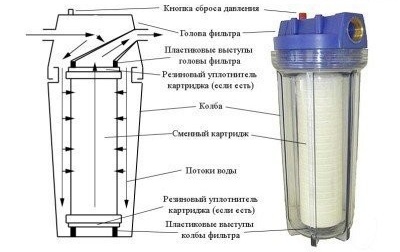
Periodically, cleaning the cartridge is recommended with special septic tanks that will kill all pathogenic bacteria. To simply remove dirt deposits from the filter element, you can rinse it under running water
Depending on the make and model, from one to four cylindrical cartridges are in containers. If they become clogged, manufacturers recommend replacing them. However, the experience of buyers shows that it is possible to extend the life of a cartridge for a while if it is rinsed with water from a hose under slight pressure or with a cleaning solution of a suitable brand.
We collect the sand filter ourselves
Stage # 1 - preparing the filter media
Quartz (glass sand) is suitable for the filtering mixture. It is loose, whitish in color. Grains are angular with a small polished surface, so they do not stick together and provide good filtration. Their diameter is 0.04-1.8 mm. According to the standards, the content of clay particles of no more than 0.12 mm is allowed. Quartz sand is resistant to alkalis and all acids except hydrofluoric (hydrofluoric).
Sand pretreatment consists of several stages:
- removal of particles not suitable in size. If you have to work with large volumes of sand, then it is quite possible to do with screening. For a small filter, remove all particles larger than 1-1.5 mm;
- sand washing. It is carried out with warm water until the water with sand becomes transparent;
- removal of bacterial contamination. Boiling sand for an hour is deadly for all bacteria. This can be done at the stake in a large capacity (20-liter can, for example). To simplify the task, you can certainly use chemistry, but then you will need to wash the sand for several hours and do a water analysis at the filter outlet.
Insert sand into the filter under a stream of flowing water. An additional layer of graphite or activated carbon will significantly improve the water quality at the “outlet”. It is better not to use more than three filter media.
Stage # 2 - assembly of the filter structure
Homemade sand filter for the pool - the thing is not the most difficult. For its manufacture, the following components will be needed:
- capacity with a wide top entrance;
- coarse quartz or glass sand;
- pump with duty valve;
- hoses;
- gaskets with gaskets;
- clamps;
- capacity with a rough water filter;
- pressure gauge;
- fine mesh water intake.
Components are the most common and are sold in any hardware store.
The pump power is selected based on the volume of the pool: water must pass through the filter at least three times a day. For example, an 8-cc pool is 24 m3 / day. If the pump capacity is 40 l / min (2.4 m3 / h), then three cleaning cycles will take 10 hours (the pump should not work without interruptions). However, there should still be a power reserve, as the system will work under pressure (for injection) or on the "suction" of water.
In the barrel, we make two holes suitable in diameter to the bends. If there is no special tool, an 80-watt soldering iron will work for work. The bends are additionally insulated with sealant. The spacing of the drives does not matter, because at the bottom there will be a collection of clean water (a tank with a coarse water filter). From it, water will be pushed up the hose and merge into the pool through the second bend.
Instead of a water intake with a coarse water filter, you can use a plastic bowl with holes, wrapped in several layers of capron from pantyhose. The mesh should be smaller, the size of sand particles.
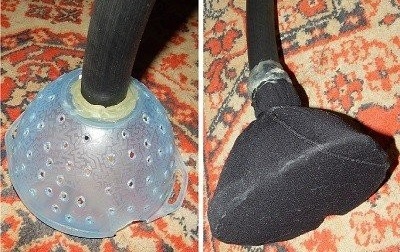
In an ordinary plastic bowl with a soldering iron we make holes with a diameter of 0.8-1.2 centimeters. We attach a hose to the sealant. We wrap a bowl of nylon from women's tights. Here you need to guess with density: sand should not seep into the catchment
Install the pressure gauge. If the pressure in the system increases by 30% or more from what it was at startup, then it is time to clean the sand with backwash.
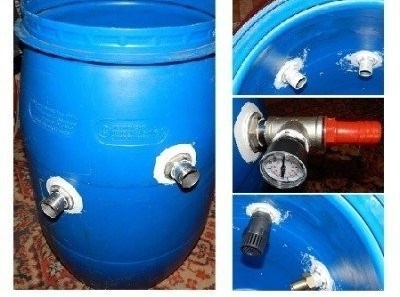
All holes must be insulated with sealant. The difference in height for the drives does not play any role in this scheme. On the "entrance" from the inside we put a grid to break the stream
We fix hoses on hot glue. For the injection from the inside of the barrel, we put a grid that will break the stream and allow you to evenly spray water on the sand.
In order to rinse the sand, you need to swap the hoses: the water from the pump must be supplied to the "outlet" of the filter, and dirt will be removed through the "inlet".
If the fastening of the daughter’s cover is too weak, it may well be ripped off under pressure. There are two ways to get out of this situation. First, of course, to improve the factory mount. Secondly, rearrange the hoses of the pump so that it does not work on pumping, but on the "suction" of water from the barrel.
Stage # 3 - installing the filter in the pool
To assemble a reliable filter does not mean ensuring high-quality water purification. Mistakes made during installation negate all material costs and human effort.
The most important thing when installing a cleaning system is circulation.The presence of "dead zones", water from which does not fall into the fence, leads to the accumulation of a huge amount of dirt and bacteria, as well as to flowering water, despite the seemingly normal operation of the filter.
The filter must draw water from the surface, as the most dirt, microorganisms and debris accumulate in the upper layer. The drain can be located at any point and at any depth of the pool. Access to the treatment plant should not be blocked by other systems, otherwise it will be difficult to replace the sand mixture.

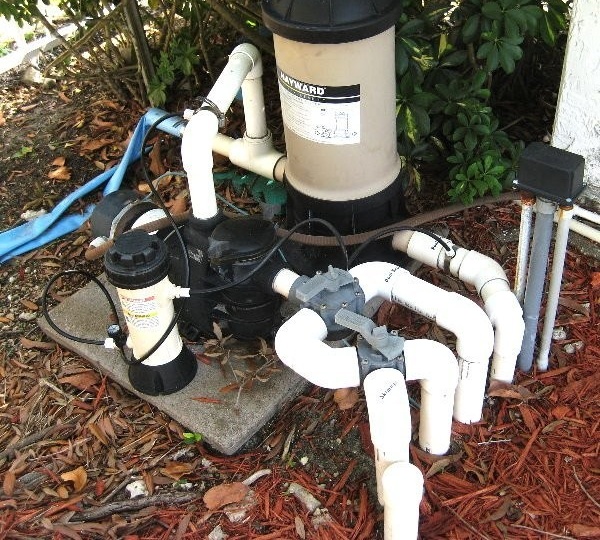

1 comment